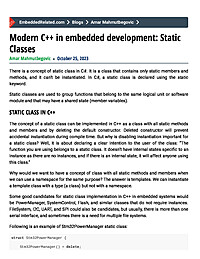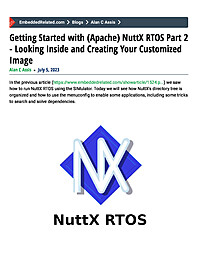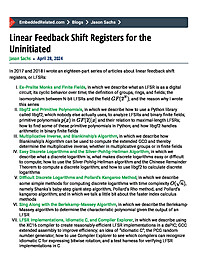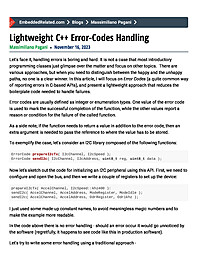
Lightweight C++ Error-Codes Handling
The traditional C++ approach to error handling tends to distinguish the happy path from the unhappy path. This makes handling errors hard (or at least boring) to write and hard to read. In this post, I present a technique based on chaining operations that merges the happy and the unhappy paths. Thanks to C++ template and inlining the proposed technique is lightweight and can be used proficiently for embedded software.
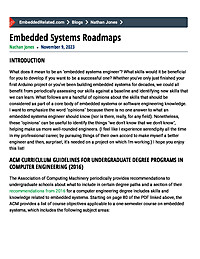
Embedded Systems Roadmaps
What skills should every embedded systems engineer have? What should you study next to improve yourself as an embedded systems engineer? In this article I'll share with you a few lists from well-respected sources that seek to answer these questions, with the hope of helping provide you a path to mastery. Whether you've only just finished your first Arduino project or you've been building embedded systems for decades, I believe there's something in here for everyone to help improve themselves as embedded systems engineers.
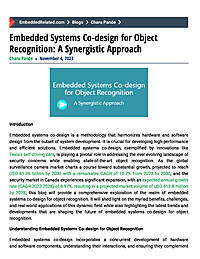
Embedded Systems Co-design for Object Recognition: A Synergistic Approach
Embedded systems co-design for object recognition is essential for real-time image analysis and environmental sensing across various sectors. This methodology harmonizes hardware and software to optimize efficiency and performance. It relies on hardware accelerators, customized neural network architectures, memory hierarchy optimization, and power management to achieve benefits like enhanced performance, lower latency, energy efficiency, real-time responsiveness, and resource optimization. While challenges exist, co-designed systems find applications in consumer electronics, smart cameras, industrial automation, healthcare, and autonomous vehicles, revolutionizing these industries. As technology advances, co-design will continue to shape the future of intelligent embedded systems, making the world safer and more efficient.
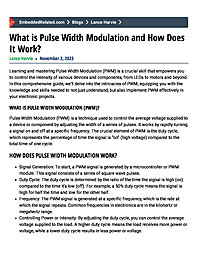
What is Pulse Width Modulation and How Does It Work?
Pulse Width Modulation (PWM) is a technique used to control the average voltage supplied to a device or component by adjusting the width of a series of pulses. It works by rapidly turning a signal on and off at a specific frequency. The crucial element of PWM is the duty cycle, which represents the percentage of time the signal is “on” (high voltage) compared to the total time of one cycle.
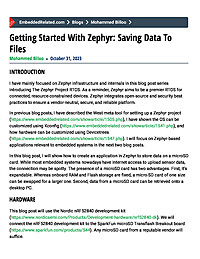
Getting Started With Zephyr: Saving Data To Files
In this blog post, I show how to implement a Zephyr application to mount a microSD card, create a new file on the microSD card, and write data to it. The lessons learned from such an application can be helpful for devices out in the field that need to write data to off-board memory periodically, especially in cases where Internet access may be sporadic.
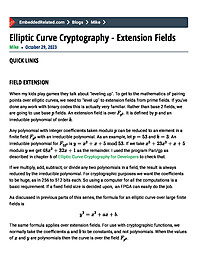
Elliptic Curve Cryptography - Extension Fields
An introduction to the pairing of points on elliptic curves. Point pairing normally requires curves over an extension field because the structure of an elliptic curve has two independent sets of points if it is large enough. The rules of pairings are described in a general way to show they can be useful for verification purposes.
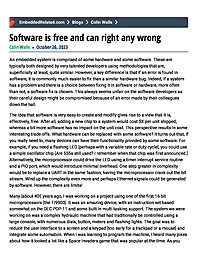
Software is free and can right any wrong
Software changes are so much easier than hardware modifications, so the temptation is always to take this approach to fixing bugs. This may not always be a good idea.
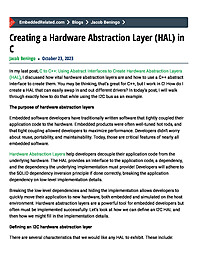
Creating a Hardware Abstraction Layer (HAL) in C
In my last post, C to C++: Using Abstract Interfaces to Create Hardware Abstraction Layers (HAL), I discussed how vital hardware abstraction layers are and how to use a C++ abstract interface to create them. You may be thinking, that’s great for C++, but I work in C! How do I create a HAL that can easily swap in and out different drivers? In today’s post, I will walk through exactly how to do that while using the I2C bus as an example.
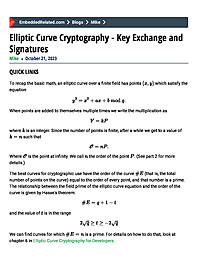
Elliptic Curve Cryptography - Key Exchange and Signatures
Elliptic curve mathematics over finite fields helps solve the problem of exchanging secret keys for encrypted messages as well as proving a specific person signed a particular document. This article goes over simple algorithms for key exchange and digital signature using elliptic curve mathematics. These methods are the essence of elliptic curve cryptography (ECC) used in applications such as SSH, TLS and HTTPS.
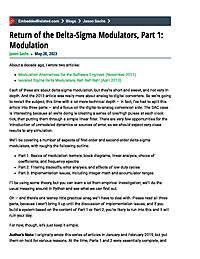
Return of the Delta-Sigma Modulators, Part 1: Modulation
About a decade ago, I wrote two articles: Modulation Alternatives for the Software Engineer (November 2011) Isolated Sigma-Delta Modulators, Rah Rah Rah! (April 2013) Each of these are about delta-sigma modulation, but they’re...
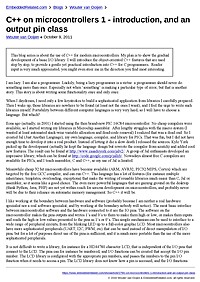
C++ on microcontrollers 1 - introduction, and an output pin class
This blog series is about the use of C++ for modern microcontrollers. My plan is to show the gradual development of a basic I/O library. I will introduce the object-oriented C++ features that are used step by step, to provide a...
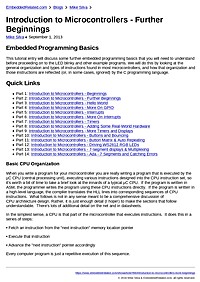
Introduction to Microcontrollers - Further Beginnings
Embedded Programming Basics This tutorial entry will discuss some further embedded programming basics that you will need to understand before proceeding on to the LED blinky and other example programs. We will do this by looking at the...
Getting Started With Zephyr: Devicetrees
This blog post provides an introduction to the "Devicetree", another unique concept in The Zephyr Project. We learn about the basic syntax of a device tree and how its structure and hierarchy mirror hardware, from the SoC to the final board. We also see how hardware described in a devicetree can be referenced and controlled in the source code of a Zephyr-based application.
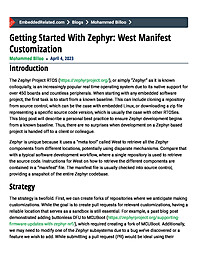
Getting Started With Zephyr: West Manifest Customization
Introduction The Zephyr Project RTOS (https://zephyrproject.org/), or simply “Zephyr” as it is known colloquially, is an increasingly popular real-time operating system due to its native support for over 450 boards and countless peripherals....
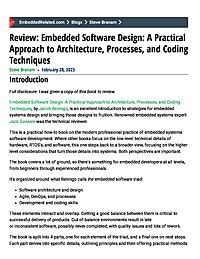
Review: Embedded Software Design: A Practical Approach to Architecture, Processes, and Coding Techniques
Introduction Full disclosure: I was given a copy of this book to review. Embedded Software Design: A Practical Approach to Architecture, Processes, and Coding Techniques, by Jacob Beningo, is an excellent introduction to strategies for...

Development of the MOS Technology 6502: A Historical Perspective
One ubiquitous microprocessor of the late 1970s and 1980s was the MOS Technology MCS 6502. I included a section on the development of the 6502 in Part 2 of Supply Chain Games, and have posted it as an excerpt here, as I believe it is deserving...
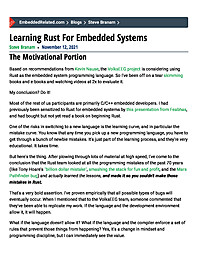
Learning Rust For Embedded Systems
The Motivational PortionBased on recommendations from Kevin Nause, the VolksEEG project is considering using Rust as the embedded system programming language. So I've been off on a tear skimming books and e-books and watching videos at 2x to...





